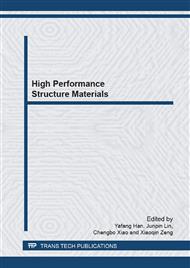p.404
p.412
p.421
p.426
p.431
p.437
p.443
p.449
p.457
Metal Flow Behaviour in Tee Joint Valve Body Multidirectional Extrusion
Abstract:
By multi-axis active load deformation method, the equivalence diameter tee joint was formed on multi-axis numerical control hydraulic press machine. The loading route was determined by numerical simulation. The experiment results showed that two loading method can complete form the parts. The different directions metal flow was observed under multi-axis loading conditions. To simplify analysis, the flow field was divided into several regions. In every region, the metal flow direction was only one. In multi-axis loading, the way of deformation follows priority deformation principle: The metal flows only choose one direction even if the work piece were under the complicated coupling field condition. The mathematical model of the deformation force and metal flow rate was established. The theoretical calculation had been provided.
Info:
Periodical:
Pages:
431-436
Citation:
Online since:
February 2013
Authors:
Price:
Сopyright:
© 2013 Trans Tech Publications Ltd. All Rights Reserved
Share:
Citation:


